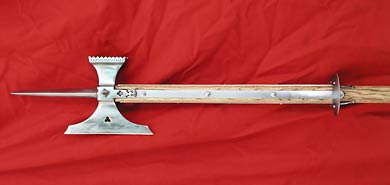|
HEY GAL posted:About the topic of magic and superstition, even smart people will, more often than not, believe the things their culture tells them to. Don't we also believe in things we can't directly see? Everyone lives in a world of meanings, formed by their culture--it's not just that things happen, it's the reasons things happen and how they're connected. Interestingly, this is something that doesn't come up nearly as frequently in medieval sources. I think it is no coincidence that the witch hunting craze is an early modern invention. This is not to say that there was no belief in the supernatural in the 11th - 14th centuries, but rather that it took on a different character, or perhaps simply did not penetrate into the minds of people who were writing at the time (i.e. largely, though not entirely, churchmen).
|
|
|
|

|
| # ? May 8, 2024 13:49 |
|
Rodrigo Diaz posted:Interestingly, this is something that doesn't come up nearly as frequently in medieval sources. I think it is no coincidence that the witch hunting craze is an early modern invention. This is not to say that there was no belief in the supernatural in the 11th - 14th centuries, but rather that it took on a different character, or perhaps simply did not penetrate into the minds of people who were writing at the time (i.e. largely, though not entirely, churchmen).
|
|
|
|
To that end it's fun to see the parallels with modern people when you read things like ancient graffiti preserved on the walls of public buildings in Pompeii. They sound tantalizingly similar to Youtube comments and stuff scrawled on bathroom stalls today.
|
|
|
|
DrSunshine posted:To that end it's fun to see the parallels with modern people when you read things like ancient graffiti preserved on the walls of public buildings in Pompeii. They sound tantalizingly similar to Youtube comments and stuff scrawled on bathroom stalls today. Every time I take a poo poo I write "I made bread" on the walls of whatever public restroom stall I'm victimizing.
|
|
|
|
Frostwerks posted:Every time I take a poo poo I write "I made bread" on the walls of whatever public restroom stall I'm victimizing. Pumpernickel
|
|
|
|
Quick question, sorry if this has been said already-I'm fairly sure I'm correct in saying that a pollaxe is this- -spike tip+axehead+blunt hammerhead. What would a weapon be called if it was like this, minus axehead? Is it still a pollaxe or is it something else?
|
|
|
|
That would likely be a bill.
|
|
|
|
Kopijeger posted:That would likely be a bill. The bill is still a bladed weapon. I think he's looking for just a big rear end hammer on the end of a pole. I'd go with either a Lucerne hammer or a bec de corbin depending on if it had a counter-balancing spike opposite the hammer or not.
|
|
|
|
If you search for fechtbucher that feature the pollaxe, such as on wiktenauer, you'll see that most of the time they're illustrated with a hammer and spike and not an axehead. This would suggest that people at the time made little or no distinction on that basis.
|
|
|
|
EvanSchenck posted:If you search for fechtbucher that feature the pollaxe, such as on wiktenauer, you'll see that most of the time they're illustrated with a hammer and spike and not an axehead. This would suggest that people at the time made little or no distinction on that basis. At the R.L. Scott Conference in 2012, we actually had a paper given by Fabrice Cognot specifically relating to the pollaxe and its various forms, as well as the language behind them. Since the stuff that most stuck in my head was their method of construction for the hammers, what I remember of terminology is a little shaky. Largely, however, you are right. Fiore, for example, calls it the azza, axe, but always depicts it with a hammer head:  The distinction between pollaxe and bec de corbin or poll hammer doesn't really show up until late in the 15th and into the 16th century, but even then it is infrequent. Rodrigo Diaz fucked around with this message at 05:06 on Sep 24, 2014 |
|
|
|
CoolCab posted:So maybe we should view this period of history as being populated by, uh unfortunately literally, developmentally disabled people? Because that makes it much more depressing As another already said, people are just as dumb nowadays, however I would put forth two arguments for there being more developmentally challenged people and fewer developmentally challenged people. On the one hand given that the preconditions were not exactly understood, it's likely, that as in the above case, people were accidentally giving themselves cognitive problems. This would not have been understood as to have been caused by a sickness, but probably due to a bewitchment or little Johnny just being stupid. Whole villages could have been horribly thick which probably confirmed the stereotype of the peasant being largely and ignorant jackass. So it wasn't a huge deal and probably existed without it coming up in reports and we could have had large populations of people being developmentally challenged. On the other hand there probably weren't as many or perhaps the usual average because the Medieval world wasn't a forgiving place. Fewer developmentally challenged person probably either didn't survive because of their disability or potentially met unfortunate 'accidents'. There were far far far fewer coping mechanisms for people with disabilities of any sort to survive. Not to say they didn't, but it would have been a far larger handicap than it would be in the modern day.
|
|
|
|
Testikles posted:On the other hand there probably weren't as many or perhaps the usual average because the Medieval world wasn't a forgiving place. Fewer developmentally challenged person probably either didn't survive because of their disability or potentially met unfortunate 'accidents'. There were far far far fewer coping mechanisms for people with disabilities of any sort to survive. Not to say they didn't, but it would have been a far larger handicap than it would be in the modern day. This French child was buried like everyone else in his or her cemetery: http://www.foxnews.com/health/2014/07/10/earliest-case-down-syndrome-discovered-in-medieval-cemetery/ And here is a 16th Century Flemish painting, The Adoration of the Christ Child:  Closeups of one of the worshipers and one of the gawking people from outside--these young men have Down Syndrome, but they're part of the painting as their model(s?) was (were?) probably part of his community. Maybe the artist knew the model/s. Unfortunately, there would have been no way to treat the heart problems that people with this disorder often have. HEY GUNS fucked around with this message at 13:31 on Sep 24, 2014 |
|
|
|
I have this impression that the steppe nomads during medieval times were relatively egalitarian and they rode around all day taking slaves, trading between the East and West, and selling themselves as mercenaries to civilized societies. How accurate is this? What was life really like for the average steppe nomad? Are there any good books on this subject?
|
|
|
|
Huskalator posted:I have this impression that the steppe nomads during medieval times were relatively egalitarian and they rode around all day taking slaves uhhhhhhh
|
|
|
|
Do you mean that they were relatively egalitarian among themselves?
|
|
|
|
JaucheCharly posted:Do you mean that they were relatively egalitarian among themselves? Yeah.
|
|
|
|
Murat Özveri told me some time ago that there's something about that in the Book of Dede Korkut. Haven't read it.
|
|
|
|
Movies/TV like Lord of the Rings and Game of Thrones seem to like depicting massed archers as always nocking, drawing, and firing in unison in response to commands. Did this ever happen? Was volley fire considered better for whatever reason? Or would it mostly have been guys taking their own shots in their own time?
|
|
|
|
thekeeshman posted:Movies/TV like Lord of the Rings and Game of Thrones seem to like depicting massed archers as always nocking, drawing, and firing in unison in response to commands. Did this ever happen? Was volley fire considered better for whatever reason? Or would it mostly have been guys taking their own shots in their own time? I'm not an expert on this, but I do know that Lord of the Rings in particular is notoriously bad at depicting how archers operate. In any of the big fighting scenes, you'll notice several elves/archers/whatever always using bow and arrows in short range melee-style encounters. (Legolas' antics are a key example of this) As far as I know, there was no example of this being a good way to fight, because in reality, in a chaotic brawl there would be no chance of nocking, drawing and firing the arrow off before you got your head cleaved in. Another key example is the use of a bow at short-range nocking, drawing and aiming at someone in order to threaten them, this would never happen, full stop. It comes from the dumb movie assumption that the bow is just a medieval gun or something. However, when regarding massed volleys, it is clear that it does happen. Maybe not to the same extent in the fiction (ie about 15,000+ people in a giant CGI army all firing their arrows at once) but rather, certainly in small groupings that can be maintained and organised by commanders on the ground to direct the group to fire in unison. Welsh/later English longbow tactics come to mind, especially their use at the Battle of Agincourt being the most well-known example. Of course, as said, not an expert so feel free to chime in to expand or correct any of this.
|
|
|
|
Averrences posted:I'm not an expert on this, but I do know that Lord of the Rings in particular is notoriously bad at depicting how archers operate. In any of the big fighting scenes, you'll notice several elves/archers/whatever always using bow and arrows in short range melee-style encounters. (Legolas' antics are a key example of this) As far as I know, there was no example of this being a good way to fight, because in reality, in a chaotic brawl there would be no chance of nocking, drawing and firing the arrow off before you got your head cleaved in. Another key example is the use of a bow at short-range nocking, drawing and aiming at someone in order to threaten them, this would never happen, full stop. It comes from the dumb movie assumption that the bow is just a medieval gun or something. Yeah but he's an elf
|
|
|
|
thekeeshman posted:Movies/TV like Lord of the Rings and Game of Thrones seem to like depicting massed archers as always nocking, drawing, and firing in unison in response to commands. Did this ever happen? Was volley fire considered better for whatever reason? Or would it mostly have been guys taking their own shots in their own time? Not the complete book, but you get an idea how it works. If you read through it, you'll understand why the laager works so well with many archers. Power Khan fucked around with this message at 12:39 on Sep 26, 2014 |
|
|
|
Smoking Crow posted:Yeah but he's an elf 
|
|
|
|
DrSunshine posted:Wow! Yeah, that's neat! Thanks for answering! So basically if you were an ordinary person you'd be a vassal of some sort, of the order? Did they divide up the administration of their realms to local governors or something? Or were they pretty much just feudal lords in everything but name? Absolutely. The Teutonic Knight specifically had Mitbrudern, or lay-brothers, who were essentially secular knights with the Order as their overlord. The knightly orders also hired a lot of people who were not full members of the order, and some serving brothers provided economic rather than military service. Monastic granges and commandries were a unit of division used by monastic orders, but often delegated: granges might have a regular steward without seeing a monk that often. The equivalent for the Monastic State of the Teutonic Knights would be a Komtur, who was responsible for feeding the local armies from their estates. I don't know that much about how the order administered their holdings: most of what I have seen on the Knights of Rhodes focused on... well... Rhodes. However, I think the big difference was the Order held lands belonged to the Order as an entity: a Komtur administers the area but doesn't own it in the way that a regular feudal lord might. Since the overlords were bound by vows of Poverty, Chastity, and Obedience, things like dynasties or amassing land for one's descendents is less of an issue. I think that would be the largest and most practical difference.
|
|
|
|
Here's the first video in Dustin Reagan's "You Pick the Technique" series. It features a play from Meyer's chapter 10, which statesMeyer's chapter 10, Forgeng's Translation posted:In the Onset when you come within a fathom of your opponent, then slash up from your right before him through his face, once, twice, three times; and in the third slashing up before him, come into the Longpoint, yet such that you remain with your left foot forward. From there, let the foible of your blade run off toward your left, and while your blade is dropping, pull your haft up at the same time; step and cut the first from your right at his left ear. As soon as this cut has hit, pull back away in a single motion and cut the second from below diagonally opposite to it at his right arm; and with this cut, keep your quillons up above your head; and with this Low Cut, step with your left foot somewhat toward his right out to the side toward him. Dustin Reagan is one of the world's best longsword fencers, as well as a well renowned translator and historian. It's a simple video of an awesome looking combination of blows.
|
|
|
|
Verisimilidude posted:Here's the first video in Dustin Reagan's "You Pick the Technique" series. It features a play from Meyer's chapter 10, which states The attacker was in a comfortable stabbing-distance for the defender multiple times. Had the defender kept up a threat while parrying, his sword would have been inside the attacker the first, or at latest the second time the attacker swung his sword behind his own head. Nektu fucked around with this message at 07:39 on Sep 30, 2014 |
|
|
|
All right, which one of you was this?
|
|
|
|
"Morgan Junior says he reached for the spear, which he keeps close to his bed."
|
|
|
|
That is an exceptionally up-close mugshot.
|
|
|
|
Nektu posted:The one thing that I dont like in that video is how passive the defender is, and that he uses the worst beginner parries available to him. The point of the weapon while he parries is somewhere in the upper left/right and does not pose a threat to the attacker, which allows the attacker to continue his series of blows (which, admittedly, is the point of the video). The context of most fechtbuchs is such that you have a student of a master fighting a common fencer. While this video is focusing on Meyer, which I don't particularly study, the Liechtenauer tradition has a similar context where you're learning the "master strokes" which are built to defeat what was referred to as "common fencing", IE the common way of fencing without proper training. It's part of why it is believed that Liechtenauer wrote his fechtbuch in cryptic verse. In order for the "master strokes" to stay within the circle of his students, they were purposefully written to be difficult to decode. We still drill in the context of fighting the common fencer, and we then adapt these plays for when we're fighting someone who probably already knows all of these same techniques. There's also something to be said about different types of parries. In our school we practice "good" and "bad" parries. By themselves neither is better than the other, but they each excel within their own contexts. A "good" parry is one such that your point is facing your opponent. A "bad" parry is like the ones you see in the video, that block the line of attack without necessarily pointing towards the attacker. Sometimes it's just impossible given the time available to make a "good" parry, so a "bad" parry suffices well enough by keeping you alive. The reality of this drill is that you probably wouldn't use it against a trained fencer, but the mechanics it teaches both the attacker and the defender are important. It's also useful for paired forms, which is quickly gaining popularity in tournaments. Paired forms is two fencers displaying practiced techniques, and they are measured by their accuracy, speed, intent, and completion of said technique.
|
|
|
|
IronicDongz posted:That is an exceptionally up-close mugshot. It's a normal mugshot, it's just that the man was actually a 10 foot-tall Forest Ogre.
|
|
|
|
Verisimilidude posted:The context of most fechtbuchs is such that you have a student of a master fighting a common fencer. While this video is focusing on Meyer, which I don't particularly study, the Liechtenauer tradition has a similar context where you're learning the "master strokes" which are built to defeat what was referred to as "common fencing", IE the common way of fencing without proper training. It's part of why it is believed that Liechtenauer wrote his fechtbuch in cryptic verse. In order for the "master strokes" to stay within the circle of his students, they were purposefully written to be difficult to decode. Verisimilidude posted:Sometimes it's just impossible given the time available to make a "good" parry, so a "bad" parry suffices well enough by keeping you alive. Verisimilidude posted:The reality of this drill is that you probably wouldn't use it against a trained fencer, but the mechanics it teaches both the attacker and the defender are important.
|
|
|
|
Verisimilidude posted:The context of most fechtbuchs is such that you have a student of a master fighting a common fencer. While this video is focusing on Meyer, which I don't particularly study, the Liechtenauer tradition has a similar context where you're learning the "master strokes" which are built to defeat what was referred to as "common fencing", IE the common way of fencing without proper training. It's part of why it is believed that Liechtenauer wrote his fechtbuch in cryptic verse. In order for the "master strokes" to stay within the circle of his students, they were purposefully written to be difficult to decode. THis comes up a lot in the punching and hugging A/T a lot. Over there there's a pretty big meh attitude towards training towards those "master combos" that work against people throwing big exaggerated haymakers because that's what drunks do, right? The thread consensus is that, drilling to he the basic body mechanics of the technique aside, that's pretty silly and hammering a technique that will get you killed by someone who passes a certain level of skill into your muscle memory is a less that ideal way to train.
|
|
|
|
the JJ posted:THis comes up a lot in the punching and hugging A/T a lot. Over there there's a pretty big meh attitude towards training towards those "master combos" that work against people throwing big exaggerated haymakers because that's what drunks do, right? The thread consensus is that, drilling to he the basic body mechanics of the technique aside, that's pretty silly and hammering a technique that will get you killed by someone who passes a certain level of skill into your muscle memory is a less that ideal way to train.
|
|
|
|
Nektu posted:It's interesting that you practice those "bad" forms on purpose. In my school its basically "ok, dont do that if you can". You still get the chance to practice fencing against the bad forms because Again, they're not really bad, hence the quotes. A "bad" parry is fantastic in that it blocks a line of attack, and opportunities exist to counter from those positions, which we often learn. You are right that things are vastly different in sparring, but that's the nature of sparring versus drilling. You drill to build muscle memory, you spar to find out how to apply what you've learned. quote:Just out of interest: what mechanics would you practice with that drill? Speed, timing, distance, parrying, and the four openings come to mind. Which school do you come from? the JJ posted:THis comes up a lot in the punching and hugging A/T a lot. Over there there's a pretty big meh attitude towards training towards those "master combos" that work against people throwing big exaggerated haymakers because that's what drunks do, right? The thread consensus is that, drilling to he the basic body mechanics of the technique aside, that's pretty silly and hammering a technique that will get you killed by someone who passes a certain level of skill into your muscle memory is a less that ideal way to train. In all fairness, we're not fighting a completely untrained goober with a sword. The common fencer of the time was fairly skilled, and knew how to use a sword, albeit differently than what Liechtenauer or Meyer may teach. What you're thinking of is commonly referred to as the buffel (buffalo, or bestial man), which is essentially a dude who's just hacking and hammering away at you. I actually took part in a workshop this weekend specifically about fighting the bestial man, and the attacks used by the buffel (as per the text) are still commonly used today, even in high level tournament settings, though less so (they're generally frowned upon for some reason). Someone won the IGX Invitational Longsword tournament with a one-handed leg snipe, which in Meyer's text (I was told) is referred to specifically as a maneuver of the bestial man, as it's easy to counter if you can anticipate it (simple geometry dictates the distance a sword has to travel to the head is shorter than the distance it has to travel to the legs). You probably wouldn't throw out that exact combination in a fencing situation, unless perhaps you're certain it will work as advertised, or you're fighting someone less skilled than you. Dustin Reagan, for instance, is probably not going to fence much differently than he does now, but he at least has the understanding and the context of that particular combination to try and understand the mindset of Meyer fencing, which generally do utilize combination attacks versus Liechtenauer's more pragmatic "as few moves as possible to win" approach towards fencing.
|
|
|
|
Verisimilidude posted:Again, they're not really bad, hence the quotes. A "bad" parry is fantastic in that it blocks a line of attack, and opportunities exist to counter from those positions, which we often learn. Developing counters from that position has to be trained, yea. And thats a good argument for what you are doing. Verisimilidude posted:You are right that things are vastly different in sparring, but that's the nature of sparring versus drilling. Verisimilidude posted:You drill to build muscle memory, you spar to find out how to apply what you've learned. Verisimilidude posted:Speed, timing, distance, parrying, and the four openings come to mind. Which school do you come from? Verisimilidude posted:In all fairness, we're not fighting a completely untrained goober with a sword. The common fencer of the time was fairly skilled, and knew how to use a sword, albeit differently than what Liechtenauer or Meyer may teach. What you're thinking of is commonly referred to as the buffel (buffalo, or bestial man), which is essentially a dude who's just hacking and hammering away at you. I actually took part in a workshop this weekend specifically about fighting the bestial man, and the attacks used by the buffel (as per the text) are still commonly used today, even in high level tournament settings, though less so (they're generally frowned upon for some reason). Verisimilidude posted:You probably wouldn't throw out that exact combination in a fencing situation, unless perhaps you're certain it will work as advertised, or you're fighting someone less skilled than you. Dustin Reagan, for instance, is probably not going to fence much differently than he does now, but he at least has the understanding and the context of that particular combination to try and understand the mindset of Meyer fencing, which generally do utilize combination attacks versus Liechtenauer's more pragmatic "as few moves as possible to win" approach towards fencing. HEY GAL posted:Yeah, but those dudes aren't planning to gank those drunks for cash/entertainment on the reg. If I went out at night looking for untrained people to harass, I'd be a sociopath. When my early modern equivalent does that it's the weekend again. Everything else is (no offense intented) just reenactement. Nektu fucked around with this message at 07:39 on Oct 1, 2014 |
|
|
|
I don't really know what kind of fencers you're dealing with, but we practice those drills because people inevitably "bad" parry, and knowing what to do in those situations is always a good thing. Drills by their nature are not absolutes. They're a way for people to practice for situations that may or may not arise. Literally every great historical fencer on this planet practices drills in this capacity. Furthermore, they're written of directly in the text. They're historical techniques, hence historical fencing. If that's reenactment to you, I don't really know what else to tell you, other than if you are picking and choosing what to use specifically in the context of tournament fighting (because, practically speaking, you will never be in a real sword fight) then you're essentially boiling it down to sport fencing. If you'd like to continue this discussion, please feel free to bring it to PMs.
|
|
|
|
Nektu posted:You either practice a martial art, or you dont. And the point of martial arts is to gently caress other people up (even if that reason d'etre has been talked away quite successfully in our modern world). If you use swords in any way, you are either sporting or reenacting. There you go.
|
|
|
|
"Gradually it was disclosed to me that the line separating sports and reenacting passes not through schools, nor between posters, nor between web forums either -- but right through every human heart."
|
|
|
|
HEY GAL posted:"Gradually it was disclosed to me that the line separating sports and reenacting passes not through schools, nor between posters, nor between web forums either -- but right through every human heart." Smoking Crow posted:If you use swords in any way, you are either sporting or reenacting. There you go. Its the same in other martial arts where everything is nice and dandy, and the first time you have to face someone who will actually hurt you (even if its only a a bit of hurt in a controlled sparring situation) everything falls apart. So, find a training parter you can trust, use wood (or a shinai) and reduce the protective gear to a low (but still sane) level, and have him hurt you (a bit, but enough) - then try to work through that. Suddenly you do the strangest things to avoid the strikes (and forget all those nice techniques you learned before). Obviously this is not for beginners. I'm also not in the least arguing against plays or drills. But those are just dancing/basic training techniques. Only pressure will make them (more) real. Verisimilidude posted:Furthermore, they're written of directly in the text. They're historical techniques, hence historical fencing. Following my line of thought, that parry was not in the texts because is was particular useful, or because the writer liked it or wanted to promote it. It was in the texts, because thats just what happened when he fell upon some poor sod that didnt know what the gently caress. You dont aspire to do techniques like that on purpose (but you *will* until you reach a relatively high level of proficiency). You do aspire to get good enough to use the more sensible parries (and as such drill those), or (as you said) to learn how to recover from such a bad position. Edit: Reading over this discussion again, it seems that Verisimilidude and I arent actually that far from each other in our positions. I probably just misunderstood the significance Verisimilidude gave that parry in his first post to the matter. Nektu fucked around with this message at 11:08 on Oct 2, 2014 |
|
|
|

|
| # ? May 8, 2024 13:49 |
|
thekeeshman posted:Movies/TV like Lord of the Rings and Game of Thrones seem to like depicting massed archers as always nocking, drawing, and firing in unison in response to commands. Did this ever happen? Was volley fire considered better for whatever reason? Or would it mostly have been guys taking their own shots in their own time? Maybe at the start of the battle you would want controlled volleys because they were... controlled, and you might not want your archers taking too many shots at long range (although you might still want to send a few shots out there rather than be entirely passive). You might also want the shooting to start on command rather than spring the trap by someone taking a shot too soon, but that also feels like a bit of a stretch. Other than that, I do not see it. All the evidence I have come across for volley fire is pretty weak, along the lines of historians taking it for granted rather than actually establishing it (assuming facts not in evidence). I see the main advantages of volley fire as: - shock action (a lot of people die at once, panicking the rest). - stagger fire by ranks (keeping up continuous shots with weapons that take a while to reload). With shock action, I think that would not work well with bows, because there is too much protection that would work against arrows. With stagger fire, the bows are fast enough that having them shoot in unison is likely to slow the archers down. You could maybe try it with crossbows, but teams with pavises and servants reloading crossbows for the main crossbowman seem more popular. In short, I think volley fire would mostly be seen as creating unnecessary delays. You might get the occasional shoot-on-command, like horse archers charging forwards and then turning and shooting when ordered, but I think it is more "start shooting now" rather than "take one shot, then wait for me to tell you stuff you already know." Nektu posted:Edit: Reading over this discussion again, it seems that Verisimilidude and I arent actually that far from each other in our positions. I probably just misunderstood the significance Verisimilidude gave that parry in his first post to the matter. And then you get people like me who hate the word "parry" at all. :P
|
|
|



























